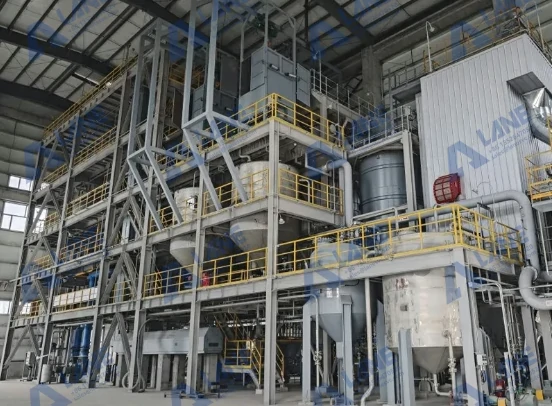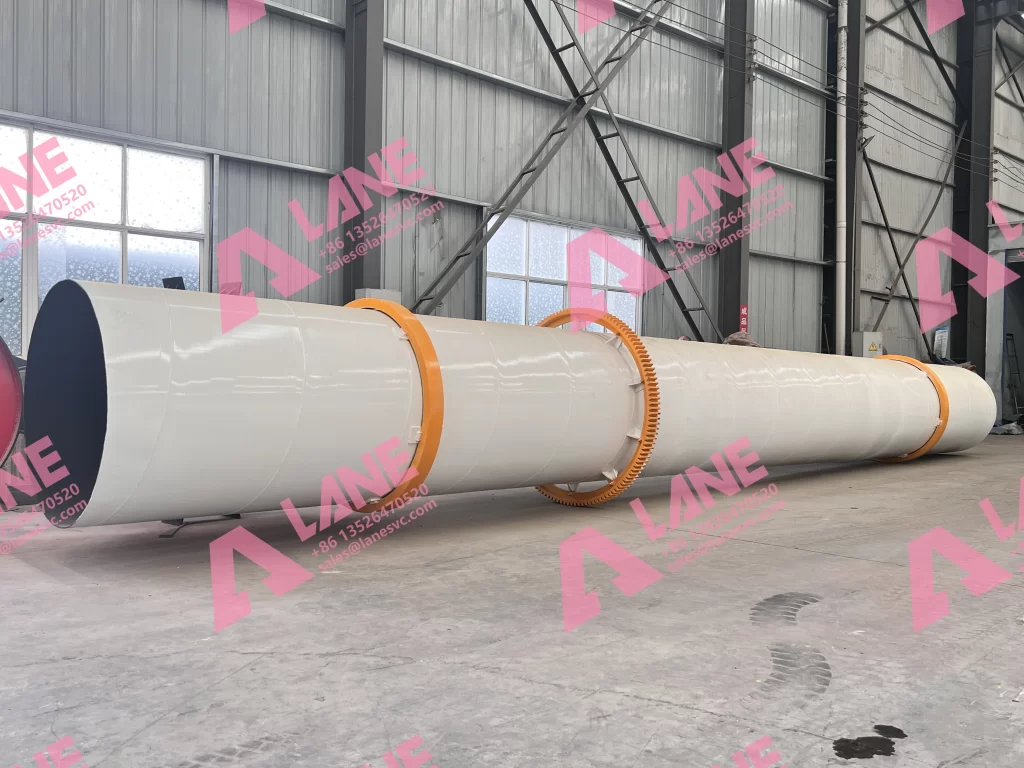
MAP fertilizer plant for sale is a keyword that has become increasingly popular among investors, fertilizer manufacturers, and agricultural groups looking to expand production capacity. Monoammonium Phosphate (MAP, 11-52-0) is one of the worldβÄôs most widely used high-phosphate fertilizers due to its high Pβ²²Oβ²Ö content, strong crop compatibility, and excellent water solubility. As global demand risesβÄîespecially in Latin America, Southeast Asia, and AfricaβÄîbuyers are actively searching for a complete, reliable MAP fertilizer plant for sale that offers high output and stable quality.
This article provides a comprehensive guide on plant configuration, process flow, costs, equipment selection, and why choosing an experienced manufacturer like LANE helps reduce risk and improve long-term profitability.

What Is a MAP Fertilizer Plant?
A MAP fertilizer plant is a production system designed to convert ammonia and phosphoric acid into monoammonium phosphate granules through controlled chemical reaction, granulation, drying, cooling, and packaging. When searching for a MAP fertilizer plant for sale, buyers typically look for a turnkey solution including:
Reaction tanks
Granulation line (disc granulator, drum granulator, or double roller press)
Phosphate fertilizer dryer and cooler
Dust collection system
Screening and coating units
Packaging and automation equipment
A standard MAP fertilizer plant can be designed in capacities ranging from 3 t/h for small agricultural supply companies to 20-30 t/h for large industrial operations.
Why the Demand for MAP Fertilizer Plants Is Increasing
MAP fertilizer is popular because:
It provides high phosphorus content for root development.
It is low in nitrogen, suitable for different soil types.
It has minimal risk of soil salinity.
It dissolves fast for drip irrigation and precision agriculture.
Countries with rapidly growing agricultureβÄîBrazil, Argentina, India, Indonesia, and EgyptβÄîare actively importing MAP fertilizer plant for sale solutions to reduce reliance on imports and strengthen local fertilizer production.
How a MAP Fertilizer Plant Works
A MAP fertilizer plant operates through a systematic and highly controlled production flow that transforms basic chemicals into stable, high-quality monoammonium phosphate granules. When evaluating a MAP fertilizer plant for sale, understanding this process is essential because it directly affects fertilizer quality, operational cost, and long-term plant efficiency. Below is a fully detailed breakdown of how a complete MAP production line runs in real industrial settings.
1.AcidβÄ™Ammonia Reaction: The Foundation of MAP Production
The core of MAP production begins with the reaction between anhydrous ammonia (NHβ²É) and phosphoric acid (Hβ²ÉPOβ²³).
This chemical combination must be precise to ensure the correct MAP grade (11-52-0).
Key operation details include:
Ammonia flow meter ensures the required stoichiometric ratio
Reactor pressures and temperatures are continuously monitored (typically 75βÄ™85¬ΑC)
Phosphoric acid concentration is controlled between 40βÄ™55% Pβ²²Oβ²Ö
LANEβÄôs reactors use anti-corrosion materials (rubber lining / stainless steel / alloy steel)
A stable reaction produces a uniform MAP slurryβÄîquality at this stage determines the final granule color, purity, and strength.
2.Slurry Granulation: Forming the MAP Core Granules
The hot slurry is delivered to a double roller granulator or disc granulator, where it coats fine particles and creates granules through layering and rolling.
Process enhancements used in LANE MAP lines:
Optimized lifting plates help the material tumble smoothly
Steam or water injection adjusts moisture for easier granulating
Internal air circulation minimizes dust and improves shaping
Granulation rate can reach 90βÄ™95%, lowering recirculation cost
Granule diameter is adjustable between 1βÄ™5 mm depending on market needs (e.g., Brazil often prefers 2βÄ™4 mm).
3.Uniform Drying: Reducing Moisture for Stability
Fresh MAP granules contain high moisture that must be reduced to ensure hardness and long shelf life.
In the rotary dryer, high-temperature air flows through the tumbling granules.
Typical drying parameters:
Inlet temperature: 280βÄ™350¬ΑC
Outlet temperature: βâΛ 80¬ΑC
Final granule moisture: 2βÄ™3%
LANEβÄôs phosphate fertilizer dryer is designed to:
Reduce fuel consumption by 15βÄ™20%
Improve heat-exchange efficiency
Minimize dust with optimized sealing rings
Drying is one of the biggest cost factors in a MAP fertilizer plant, so efficiency here directly affects profit margins.
4.Cooling: Strengthening Granules and Preventing Caking
After drying, granules are still hotβÄîtoo fragile to package and prone to sticking.
A rotary drum cooler pulls ambient air through the drum to:
Lower granule temperature
Harden the structure
Reduce future lumping during storage
Proper cooling improves the crushing strength of MAP granules, ensuring they can endure long-distance transportation.

5.Precision Screening: Achieving Market-Ready Granule Size
Screening classifies granules into three categories:
Qualified granules βÜ£ sent to coating
Oversized granules βÜ£ crushed and reused
Fines βÜ£ returned to the granulator
Why this matters:
Ensures product meets international standards
Improves dissolve rate in drip irrigation
Supports consistent nutrient application in mechanized farming
LANE uses low-noise, sealed rotary screeners ideal for phosphate-based materials.
6.Coating: Protecting MAP From Moisture and Caking
A thin coating layer is crucial for MAP fertilizer stored in humid or tropical climates.
LANEβÄôs coating systems apply:
Anti-caking agents
Mineral oils
Moisture-proof additives
This step enhances:
Flowability
Long-term storage stability
Resistance to humidity changes
Many customers in Southeast Asia, Africa, and Latin America consider coating mandatory due to year-round moisture.
7.Packaging and Automated Handling
Finally, finished MAP granules are transferred to the packing section.
LANE provides:
Electronic weighing bagging machines (25βÄ™50 kg)
Big-bag jumbo packers (500βÄ™1000 kg)
Optional robotic palletizers for full automation
The packaging accuracy is typically within ±0.2%, minimizing product wastage and labor dependency.
A complete MAP fertilizer plant for sale from LANE is delivered as a turnkey systemβÄîcovering plant layout design, 3D engineering drawings, equipment manufacturing, overseas installation guidance, and after-sales training.
FAQ: MAP Fertilizer Plant for Sale
1.What is the main raw material needed for a MAP plant?
Ammonia and phosphoric acid.
2.What granulation method is best for MAP?
Double rolller granulation and disc granulation are most common.
3.Can the plant produce different granule sizes?
YesβÄî2βÄ™5 mm is standard, but LANE can customize.
4.Does LANE provide on-site installation?
Yes, both on-site guidance and remote technical support.
5.Can MAP and DAP be produced in the same factory?
YesβÄîmany customers build a combined NPK facility.
Conclusion
If you are searching for a professionally designed MAP fertilizer plant for sale, choosing the right equipment supplier is crucial. LANE offers complete, flexible, corrosion-resistant MAP plant solutions that help customers achieve long-term stability, lower energy consumption, and faster ROI.
Whether you need a small 5 t/h line or a large 30 t/h integrated plant, LANEβÄôs engineering team can provide full turnkey support.

Of course, we also offer other types of products for your different needs, you can click to view.
For more information, please contact us by sending an inquiry today! We can help you!
Copyright © Henan Lane Heavy Industry Machinery Technology Co., Ltd.